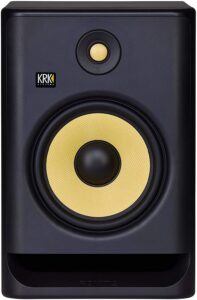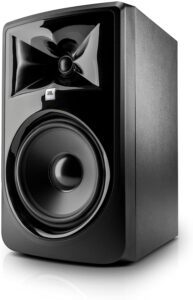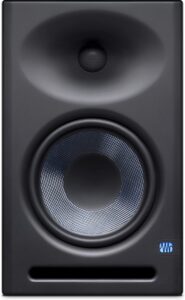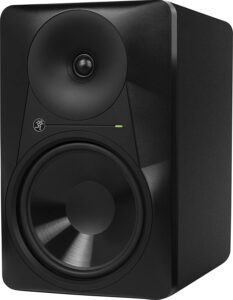Are you looking for the best studio monitors for bass? Then, you are in the right place.

Music producers, composers, and musicians inevitably and invariably turn to high-quality studio monitors for creating pure and sonorous low-end tunes. Likewise, studio monitors come in very handy for composing music loaded with bass, including rock, hip-hop, electronic dance music, and trap.
A good studio monitor offers a better soundstage than standard speakers and is indispensable for delivering the entire gamut of low-frequency sounds.
In this review on the best studio monitors for bass, we’re going to walk you through the top 4 studio monitors that’ll enable sound producers to compose music reinforced with excellent bass.
The 4 Best Studio Monitors for Bass
| Image | Model | Price |
|---|---|---|
 | KRK RP8 (Top Pick) | Check Price |
 | 308P MkII (Close Runner-Up) | Check Price |
 | PreSonus Eris E8 XT | Check Price |
 | Macie MR824 | Check Price |
KRK RP8 Studio Monitor (Editor’s Choice)
The RP8 Rokit 8 G4 Professional Bi-Amp 8” Powered Studio Monitor from KRK makes the most versatile Kevlar drivers for delivering accurate, taut bass. This matte-black 2-way active studio monitor speaker takes full advantage of premium speaker drivers that guarantee uniform sonic output across highs, midrange, and low-ends. On the other hand, the matching drivers embedded in this KRK RP8G4 studio subwoofer deliver sound in a way that diminishes listening fatigue.
DSP-enabled (digital signal processing) ‘Room Tuning’ integrated with 25 visual graphic EQ settings aid in minimizing and remedying room acoustics. The bespoke performance-driven Class-D powered amp help drive the speakers consistently at low operating temperatures, eventually boosting acoustic intensity. In addition, the KRK RP8 studio monitor is thoroughly compatible with the KRK App, enabling you to set up your studio for quicker mixing and superior control.
The integrated Brick Wall Limiter gets activated automatically at the highest amp-level for guaranteeing consistent sound with broader dynamics. At the same time, the Brick Wall Limiter goes a long way in helping you to keep your studio sound equipment setup safe and secure. In addition, there is minimal colorization and distortion of sound, thanks to the low-resonance. At the same time, the thick Iso-foam padding disengages the speaker externally to reduce vibration for enhanced clarity.
The KRK app that works with Android and iOS operating systems allows you to take acoustic monitoring to the next level. The app makes it effortlessly easy to calibrate EQ settings with precision which ultimately helps in appropriate sub positioning and level matching with other speakers via the real-time Room Acoustic Analyzer.
Pros
- Audiophile-grade design with a heavy-duty Class-D amp for driving the speakers efficiently
- Advanced DSP incorporating LCD visual EQ and room acoustics correction for ensuring a riveting soundstage
- Optimal high-frequency waveguide for delivering a profound and vibrant sweet spot with extraordinary imaging
- The front-firing port ensures exceptional bass response and helps in simple speaker placement
- Compact Kevlar drivers for outputting excellent sound with minimal feedback and microphonics
Cons
- Some users have reported that the tweeters produce a piercing hiss even without connecting audio inputs
- Remarkably expensive
JBL 308P MKII Studio Monitor
The 8” JBL Professional Studio Monitor 308PMK II is an upgraded state-of-the-art high-powered monitor supremely capable of belting out premium low-end sounds. This studio monitor is highly sought-after by sound producers and musicians thanks to its ground-breaking JBL Image Control Waveguide and sophisticated transducers. In addition, the 308 P MKII comes equipped with striking details, an extensive sweet spot, accurate imaging, and an imposing energetic workspace.
These practical features work in concert, enabling you to squeeze out the most of your studio’s audio mixing capabilities. Using patented technologies obtained from JBL 7 Series and M2 Master Reference Monitors to maximum advantage, the 308 PMKII guarantees superb performance. On the other hand, this sleek studio monitor from JBL is ideal for ensuring an exciting and effective mixing experience.
This 3 Series MKII 308P as an upgraded LSR3 studio monitor perfectly embodies the JBL’s traditional and pristine sound performance. As an MKII Series speaker, the 308 P comes with advanced and reorganized LF (low-frequency) and HF (high-frequency) transducers. The HF and LF transducers furnish the best possible damping for better transient response and guarantee superior linearity for facilitating deep bass typified by lower THD.
Record producers will also put upgrades like ‘new boundary EQ’ that re-establishes neutral LF response (when speakers are positioned on adjacent walls and work surfaces) to excellent use.
Pros
- Advanced Boundary EQ settings to compensate for environmentally-driven low-frequency aberrations
- Avant-garde transducers for best possible transient response and boosted bass reproduction with lower THD
- The glossy, futuristic design accentuates the overall décor of any recording or filmmaking studio
- It comes with a built-in mic which is a unique feature
- HF Trim switch for effortless adjustment high-frequency output for accommodating room acoustics
Cons
- At maximum volume, white noise becomes unbearable (there is white noise even when you switch on the speakers)
- Lessening the volume level gradually mutes noise as well as sound output
PreSonus Eris E8 XT Studio Monitor
Composers and music producers warm up to the Eris E8 XT 8” Near Field Studio Monitor integrated with EBM Waveguide owing to the speaker’s accurate and mellifluous frequency response. Additionally, the Eris E8 EX monitor finds sweeping use in recording studios because of its high-level amplification characterized by plenty of headroom and acoustic tuning capabilities. Thanks to being loaded with multiple functional features, the original Eris-Series monitors have become best sellers.
And the Eris E8 XT builds on the legacy of that classic Eris Series studio monitor, featuring a broader better controlled sweet spot with deeper lows. In addition, this Eris XT studio monitor now comes outfitted with an all-new Elliptical Boundary Modeled (EBM) waveguide for an ultra-wide sweet spot. The EBM waveguide results in a better high-frequency response with a broader 100° linear dispersion, thus generating an extended sweet spot.
Pros
- 1.25-inch silk dome high-frequency tweeter for soft mellowed highs
- Knitted composite low-frequency transducer for more profound low-ends
- Rock-solid defense against RF interference, overheating, and short-circuitry
- High-tech front-ported enclosure for reproducing taut low-end frequencies
Cons
- The loudspeaker enclosure or cabinet could have been stronger
- It comes with low-quality cables
Mackie MR824 Studio Monitor
The Mackie MR824 8-inch powered studio monitor has been designed meticulously to guarantee a powerful performance. This MR Series studio monitor with 65W of Class A/B amplification is ideal for high-quality, lucid audio mixing and mastering. Taking inspiration from Mackie’s long-standing studio monitor designing experience, the MR824 is perfectly fine-tuned for remaining faithful to any mixing, be it rock, dance, or hip-hop.
The Mackie MR824 provides an extra-wide stereophonic imaging and acoustic sweet spot with an established scaled waveguide track record. On the other hand, the Acoustic Space controls help make adjustments to this studio monitor’s frequency response for syncing with your studio. Featuring the shelf-ported MRS10 studio sub, the Mackie MR824 improves the reproduction of open and deep bass sounds for your low-end mixing.
Pros
- 8-inch polypropylene woofer for accurate delivery of dynamic and responsive low-frequency sound
- 1” dome tweeter crafted from silk furnishes quick, fleeting response, thereby ensuring comprehensive voicing clarity and high-end frequency reproduction
- 65W of booming bi-amplified Class A/B acoustic amplification and extension
- It comes in handy for high-quality mixing translations with accurate results in any studio recording
Cons
- The location of the power switch on the back in a discreet position does not help
- If you’re someone who prefers resounding bass, then this monitor is not for you.
FAQs About Best Bass Studio Monitors
Difference Between Studio Monitors and Speakers
At first glimpse, studio monitors and standard Hi-Fi speakers might look identical as both speakers sport a vertical rectangular structure.
There’s a big difference between a studio monitor and a regular speaker in performance and applications. For example, studio monitors are ideally placed for audio mixing, recording, mastering motion pictures, television, and gigging.
Studio monitors are used across the board in different types of studios, including but not limited to radio studios, film studios, and recording studios. The expression ‘studio monitor’ is primarily used by audio engineers and sound producers as the speaker is painstakingly designed for delivering moderately smooth DSP and frequency response. Home hi-fi speakers, on the other hand, by and large function as passive speakers (calling for external amplification) for DRC (dynamic range compression) commercial sound production.
Studio Monitors
You can easily mistake a studio monitor for a hi-fi loudspeaker or bookshelf speaker, but the former is created exclusively for serving specific applications. A studio monitor is an acoustic transducer positioned inside a loudspeaker enclosure or cabinet. Studio monitors are generally used for commercial sound production purposes like filmmaking, recording studio, television studio, and home or project studio.
A studio monitor is a loudspeaker that reproduces specific frequencies with nominal emphasis resulting in seamless replication of the source audio’s tonal qualities. At the same time, the exhibition of a particular frequency range with minimal de-emphasis implies that there is hardly any sonic coloration or soundstage distortion during studio recordings. Besides stereophonic recording, studio monitors are also widely used for audio mixing and mastering applications and filmmaking that require the reproduction of spacious environments such as theaters.
The close-field/compact profile of monitors (near-field) means these speakers have a relatively small footprint, letting you place them easily on a desk. In addition, since you can position a studio monitor quite close to yourself, your ears pick up most of the sound reflected by the speaker. Simply put, a studio monitor’s small footprint allows the loudspeaker to direct the sound towards the listener instead of the audio bouncing off of ceilings and walls, leading to distortion and coloration.
Studio monitors usually come equipped with two types of driver, i.e., a woofer and a tweeter, enabling them to produce low-frequency sounds.
Studio Monitors vs. Standard Speakers
Though studio monitors and standard speakers are alike in many respects, there are some noticeable differences between the two categories of loudspeakers. Following are some of the technical aspects that’ll help you to differentiate a studio monitor from a regular speaker:
- Sound. Since a studio monitor doesn’t highlight any specific frequency, they give off an even sound perfect for near-field listening.
- Crossovers. A studio monitor has a distinct edge over the regular speaker version. The former is equipped with crossover capability letting the speaker split frequencies for directing them to the appropriate speaker driver. The crossover functionality allows the studio monitor to reproduce sound with better clarity and accuracy across the EQ band.
- Specific power amps. Studio monitors invariably feature a host of amps embedded inside a single enclosure, including midrange and treble (tweeter) cones and a woofer (bass).
- Active or passive. Studio monitors are always active. This is because they come with a built-in power amp. Conversely, home hi-fi speakers need an external amplifier to amplify their audio signals and therefore tend to be passive.
How to Choose A Good Studio Monitor
Selecting a regular or standard hi-fi home loudspeaker is more often a straightforward affair as you can choose from several options. However, picking and choosing a good quality studio monitor is an entirely different ballgame as these speakers have specialized applications. When you’re shopping for a topnotch studio monitor, consider the following attributes:
- Size of the monitor. Size is the first and foremost thing you should take into account. The installation or mounting space available in your studio desk will determine the size you should go for. You can select large studio monitors for a small space, provided they’re mountable. If you need more bass, your studio monitors should be relatively big, e.g., 8” – that’s why it’s the size of all the models we review in this article.
- Bi-amp or single-amp monitor. Choosing a monitor with a bi-amp configuration is recommended because this unit reproduces a better quality of sound than a single-amp monitor.
- Input connectivity. High-end, versatile studio monitors usually feature a host of connectivity options like SPDIF, TRS, XLR, and much more. No matter whatever product you finally select, make sure the unit supports connections companionable with your studio musical equipment setup.
- Cabinet structure. This is one consideration overlooked mainly by many musicians and record producers. Nevertheless, the material from which the product is constructed can considerably influence the sound quality. See that the monitor you purchase has been crafted out of metal, wood, or hard plastic.
- Power output. Speaker wattage rating is one of the most crucial aspects you should consider while purchasing a monitor speaker. Opting for a studio monitor with high wattage is the way to go if you have a spacious room and vice-versa.
So, The Best Studio Monitor for Bass Is…
Since studio monitors are available in various types, sizes, and shapes, the product that’ll work for you depends on your specific needs and preferences. However, the key attributes you should keep in mind while shopping for your ideal monitor have been outlined in the FAQ section.
All the studio monitors models reviewed above more than fit the bill for applications relating to commercial sound production, focusing mainly on low-end melodies.
The RP8 Rokit 8 from KRK has a slight edge over other models due to its built-in Class-D amp and unique features like LCD screen (that displays the EQ settings), Brick Wall Limiter, and so on. However, the 308P MKII from JBL and MR824 from Mackie can give the Rokit 8 a good run for its money.